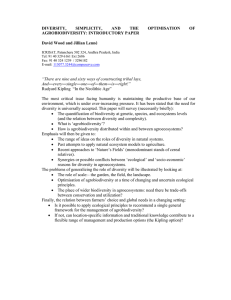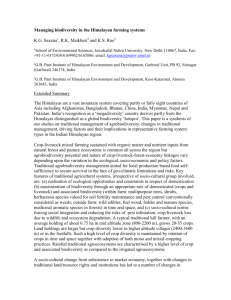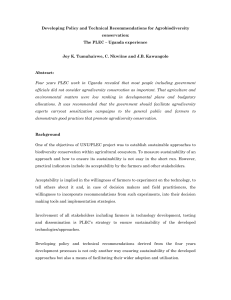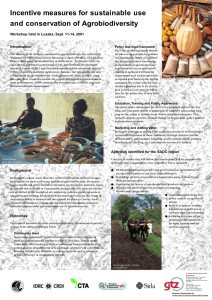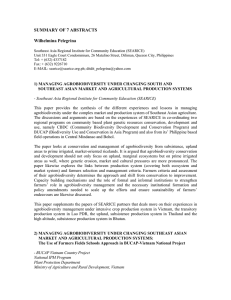Nutrition and Health
advertisement
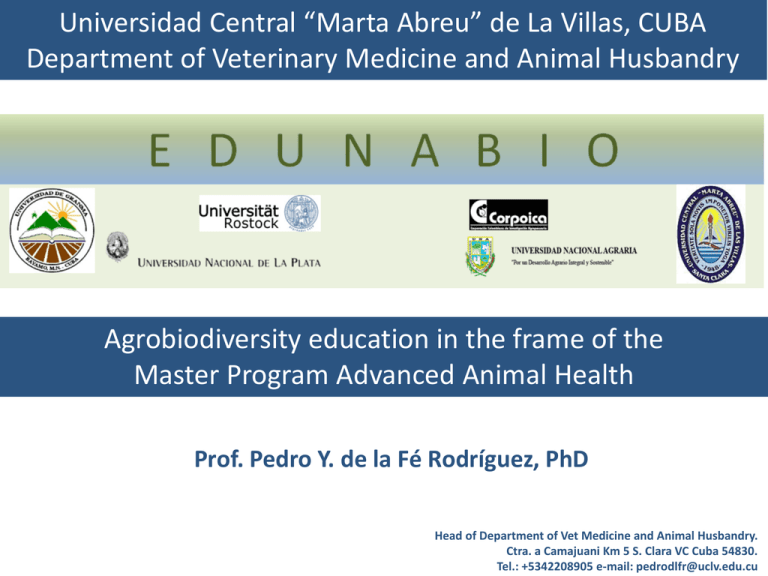
Universidad Central “Marta Abreu” de La Villas, CUBA Department of Veterinary Medicine and Animal Husbandry Agrobiodiversity education in the frame of the Master Program Advanced Animal Health Prof. Pedro Y. de la Fé Rodríguez, PhD Head of Department of Vet Medicine and Animal Husbandry. Ctra. a Camajuani Km 5 S. Clara VC Cuba 54830. Tel.: +5342208905 e-mail: pedrodlfr@uclv.edu.cu Introduction Courses Obligatory Research Methodology Molecular Biology Biostatistics Molecular Epidemiology Proteins: studies and application in biosciences Immunology Nutrition and Health Biosafety Programs for Diseases Control Methodologies for the diagnose Optative Bioinformatics Advances in animal nutrition Poultry diseases Zoonosis Food safety Internal Diseases of Animals Reproduction: biology and pathology Module Credits I I I II II II III III III III 3 3 3 3 3 3 3 3 3 3 IV IV IV IV IV IV IV 2 2 3 3 3 3 3 Introduction Research activities Credits Publication in a national journal 2 Publication in an international journal 4 Presentations in national events 3 Presentations in international events 4 Publication of a monograph 1 Approval of projects, patents or registers 2 Resume of the program Obligatory courses Optative courses Thesis Optative from research activities Total Credits 30 20 38 16 104 Methodologic work Selected Courses for emphasizing on agrobiodiversity Time distribution Course Module Credits Presential Independent work Total 36h (25%) 108h (75%) 144h Nutrition and Health Programs for diseases control III Biosafety Molecular biology I 3 Methodologic work Current target topics in every selected course: how agrobiodiversity education should be implemented Course Nutrition and health Antinutritional factors. Strategies in animal feeding: Introducing sustainable strategies to attenuate antinutritional factors from local plants (candidates for animal feeding) in order to efficiently use them as alternative local resources. Biostimulants in animal nutrition: Deepen in the study of biostimulants of vegetal origin that can be obtained locally. Also, special emphasis on bee products should be considered. Prebiotics, probiotics and cofactors: Explaining the fact that the diverse surrounding environment is a source of these elements. Nutrients: Importance of recovering, maintaining and enriching biodiversity in order to have different sources of the diverse nutrients. Uses of biotechnology for the preparation of food for animal feeding: Regulations regarding the use of genetic modified organisms for animal feeding and during the preparation of food, as well as their repercussion on agrobiodiversity. Toxics and toxic plants in animal feeding: Studies on how to diminish the toxic effect of some plants and how they can be controlled by environmental friendly methods. Methodologic work Current target topics in every selected course: how agrobiodiversity education should be implemented Course Programs for diseases control In most of topics related with infectious diseases: Hemolytic, Diseases of the Central Nervous System, Gastroenteric, Respiratory diseases, Skin and muscles diseasess, Swine red diseases, Granulomatous diseases, Retroviral diseases Emphasizing in the sources and ways of transmission of pathogens, especially in how the wild fauna affect farm animals, but also must be introduced the ways livestock influence on wild fauna Focusing the majority of problems of emerging and reemerging diseases as the result of disruptions of ecosystems and biodiversity. Introduction to researches in wild fauna genomics, aimed on looking for pathogens-resistant genes or even antibiotic/antiparasitic susceptibility genes for application in livestock. Multispecies farms and biodiversity. Epidemiological risks of multispecies farms because of multispecies adaptation of pathogens. Improving biodiversity by diversification of animal strains, and also by diversification of pathogens. Use of alternative methods for controlling pathogens identifying/using biotic relations and medicinal plants from the same agroecosystem. Methodologic work Current target topics in every selected course: how agrobiodiversity education should be implemented Course Molecular Biology Mechanisms of genetic conservation: Explaining how to use genetics in order to recover, maintain and enrich biodiversity. Transposons and Transposable elements: Explaining the mechanisms of transmission of resistance through mobile genetic elements from animal microbiota to microbial ecology, and vice versa. Course Biosafety Regulations regarding biotechnology policies, ethics, property rights, safety and socio-economic problems. Biosafety and biotechnology. Definition and perception of risks for the agriculture: Emphasizing on genetic modified organisms and the role of veterinarians in the interface wildlifelivestock/domesticated animals/laboratories: what do they have to know about biodiversity? Methodologic work Evaluation of the courses Routine evaluations (seminars, practicums, homework, informs) Final exam (Programs for Diseases Control and Molecular Biology) Bibliography for the courses Access to information University libraries (faculty and university ones, Institute of Plant Biotechnology and Centre for Agriculture Research). Every course has a folder in the central server of the faculty network containing the program of the course, electronic books, scientific papers, materials elaborated by professors, thesis of former students, PhD thesis, virtual laboratories. Interactive platform in Moodle. The central library of the University warrant access to the main international databases. Every student has an University account to access internet and international mail. T Thanks for your attention
